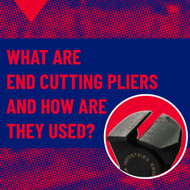What Are End Cutting Pliers And How Are They Used?
26th May 2023
If you want to cut a nail or wire really close to a surface, traditional cutting pliers won't quite give you the finish you need.
So what tool do you need?
That's where end cutting pliers come in, your precision tool for cutting close to any surface.
What are end cutting pliers?

End cutting pliers (often called end nippers or end cutters) are a set of pliers with a cutting edge designed to help cut through material with a flush finish. The cutting jaws of these pliers are perpendicular to the handle, allowing it to sit flush with the surface, creating a cut that avoids extra material rising above the cutting surface.
What are end cutting pliers used for?
End cutting pliers are most commonly used to cut nails close to the surface of wood, or for trimming metal wire or bolts. The shape of the jaws allows them to perform flush cuts against a surface, which makes them useful in the following ways:
- Cutting nails in wood is a primary application of end cutters, ideal if you're reusing a piece of wood from an old project.
- Top cutting hard wire – end cutting pliers are ideal for cutting through hard wire, such as in spring mattress manufacturing or wire spring making.
- Jewellery making – these are excellent for trimming flat wire or cutting off the end of an ear stud.
- Repetitive hard wire cutting – often used during metal fabrication work.
- Pulling nails from wood – these pliers can be used to pull out nails from wood, by holding the nail gently, and then levering them out. Ideal for carpenters.
- Removing electrical staples – traditional pliers can't get close enough to electrical staples without risking damaging the wire, whereas end cutters can push right up against the staples, helping to safely remove them and relocate the cables.
How to choose end cutters?
Not all end cutters were made equal, so we recommend you look for the following features for your next set:
- High leverage – your hands get tired very quickly cutting through hard wire and nails. It's best to choose a tool with a high force multiplier, to help save your energy during repetitive cutting.
- Hardened cutting edges – there's no point in owning a pair of cutting pliers that goes blunt after a few uses, so look for something with a high HRC value (Rockwell Hardness) to ensure it'll keep cutting for many years. HRC 64 is a good number to go for.
- Return spring – having a return spring will save you time and energy by helping you reset the tool to its starting position.
- Cutting capacity – look for a strong tool that can handle the wire you need to cut. The best tools will be able to handle 2mm diameter hard wire, and some even cut through piano wire.
Best end cutters
The Maun End Cutting Plier for Hard Wire 150 mm fits all of the criteria mentioned above, with a particularly high leverage multiplier of 14x (plus it's UK made).

How to use end cutting pliers
End cutting pliers are really simple to use for cutting wire:
- Insert the wire into the jaw of your end cutters.
- Squeeze the handles tightly together until the wire has been cut.
- Relax your grip to start again.
If using them to cut or remove electrical wire staples:
- Place the open jaws of the end cutter next to the side of one of the staples, making sure not to touch the wire.
- Squeeze gently to get a firm grip on the staple.
- Pull the staple away from the surface until it has either been removed, or the tool has lifted it as high as it can.
- Then reset the tool and repeat until the staple has been completely removed.
Can you use side cutters instead of end cutters?
You can of course try to make do with side cutters instead of end cutting pliers, but the results will be inconsistent and could prove costly. It's always better to get the job done right the first time.
Learn more about side cutters here.
Side cutters vs end cutters
Side cutters (or diagonal cutting pliers) are distinctly different from end cutting pliers. Side cutters have an angled edge, applying a greater cutting force onto wire, that indents and wedges wire apart.
In comparison, end cutters have a flush edge, which helps them get very close to the cutting surface.
Browse all types of pliers here.
Can end cutters cut nails?
End cutters are very useful at cutting nails, as they cut them very close to the surface of the material they're embedded into, making them safe. This is useful when you want to reuse a piece of wood for another project, but can't or don't want to remove the nail.
Carpenters pincers vs end cutters
Carpenters pincers tend to have a more rounded tool head with blunt jaws, making them more useful for retrieving old nails, whereas end cutters have narrower sharper jaws, designed more for cutting through nails.
Conclusion
We hope you enjoyed our article on end cutting pliers. If you have any questions, feel free to contact us. Want to read more? Consider our related pages below:
- What are Side Cutter Parallel Pliers?
- What is an Olive Cutter
- What are End Cutting Pliers?
- What are Fencing Pliers and How to Use Them
- How to Cut Hard Wire?
- How to Cut Laminate Flooring
- Best Wire Cutters
- Best Side Cutters
- Best End Cutters
- How to Cut Up Mattress Springs
- Best Fencing Pliers
- How To Cut Wire with Pliers
- Wire Cutters
- Side Cutters
- End Cutting Pliers
- Heavy Duty Wire Cutters
- Side Cutter Parallel Pliers
- Olive Cutters

